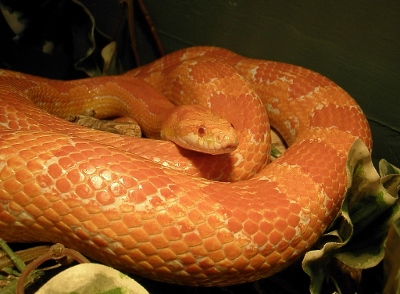
August is winding down and our Animal of the Month, the corn snake, is now slithering off into the sunset. We hope you enjoyed the fun facts we tweeted about these easy-going snakes throughout the month. Check out our Twitter account @ExoticPetVets next week when we reveal our next Animal of the Month. But first, here’s a summary of our tweets about the corn snake in case you missed any. Did you know?:
- The corn snake (Pantherophis guttatus) is part of the Colubridae family of snakes.
- There are more than 1,000 species of Colubrid snakes, but the corn snake is one of the most popular pets from this family.
- Corn snakes make great pets as they are docile and adapt well to captivity.
- Captive-bred corn snakes from a reputable breeder are better as pets than wild-caught snakes.
- Wild-caught corn snakes are more sensitive to stress and can harbour more parasites.
- Captive-bred corn snakes come in a variety of colour and pattern varieties after many years of selective breeding.
- Corn snakes don’t have eyelids and can’t close their eyes. They have a single clear scale called a spectacle over each eye.
- Corn snakes smell with help from their tongues. They flick their tongues to gather odour chemicals.
- The corn snake’s tongue helps transfer odour chemicals to what’s known as the Jacobson’s organs.
- The Jacobson’s organs are two fluid-filled sacs at the roof of a corn snake’s mouth, which help decode chemical messages.
- Corn snakes don’t eat corn or any other vegetables. All snakes are carnivorous (meat eaters).
- Corn snakes get their name from the days when farmers in the southern U.S. stored their corn in a log or wood structure.
- Rats and mice arrived to eat the corn and the corn snakes showed up to eat the rodents.
- You can’t easily tell male and female corn snakes apart just by looking at them as they appear almost identical.
- A reptile vet can determine the sex of a corn snake by probing the snake’s cloacal area with a special instrument.
- A corn snake’s cloacal area is where the reproductive, urinary and digestive tracts meet in a common cavity.
- Corn snakes are constrictors and will bite their prey before wrapping themselves around their intended meal.
- Corn snakes will squeeze their prey until it suffocates before swallowing it whole.
- Corn snakes in captivity should eat rats and mice that are already dead for the safety of the snake.
- If live prey is put into a corn snake’s enclosure and the snake isn’t hungry, the snake could be bitten by the prey.
- Corn snakes, like all snakes, are not slimy as many people are led to believe. Their scales are dry.
- Corn snakes like to burrow, so your pet corn snake should have a place to hide in her enclosure.
- You can provide your corn snake with a box and pine chips or “Astroturf” under which she can hide.

